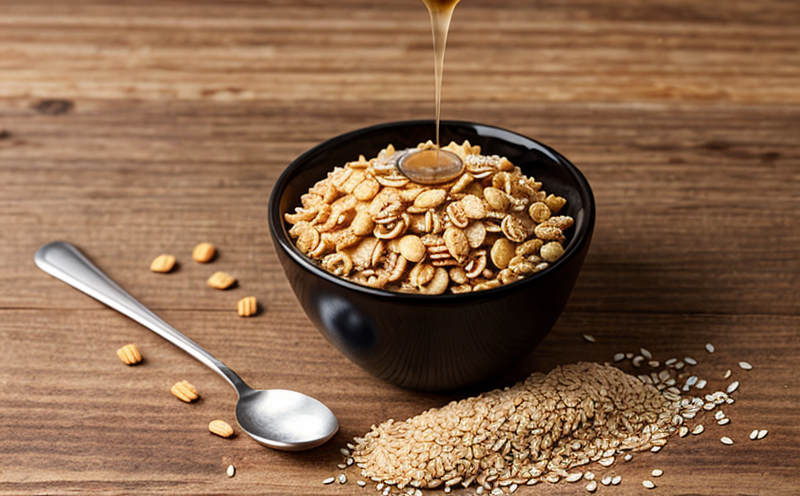Peroxide Value of Oils Iodometric Test
The peroxide value (PV) is a crucial parameter in assessing the oxidative stability and freshness of fats and oils. In the iodometric method, this test measures the amount of peroxides present in edible oils or fats by titrating with sodium thiosulfate solution using starch as an indicator.
This testing methodology adheres to international standards such as ISO 5563-1:2015 and ASTM D978. The iodometric approach is preferred for its simplicity, accuracy, and reliability in detecting peroxide levels which indicate the degree of rancidity or oxidative stress that can arise during storage or processing.
The test involves extracting a known quantity of oil using chloroform or another inert solvent. This extract is then titrated with a standardized iodine solution until it reaches the endpoint, typically signaled by a blue coloration changing to clear due to starch acting as an indicator. The calculation of PV requires precise measurement and calibration techniques.
Understanding the peroxide value helps quality managers ensure product integrity, maintain shelf life, and comply with food safety regulations such as those outlined in Codex Alimentarius standards. This test is especially critical for manufacturers of cooking oils, margarines, shortenings, and other edible fats where oxidative degradation can lead to off-flavors and reduced nutritional quality.
The iodometric method’s simplicity allows it to be widely applied across various laboratory settings. However, the accuracy of results heavily depends on standard operating procedures (SOPs) and the precision of the equipment used for extraction and titration.
- Compliance with ISO 5563-1:2015 ensures the method is validated and standardized for global acceptance.
- The use of starch as an indicator allows for clear endpoint detection, enhancing the reliability of results.
- Precision in the extraction process is crucial to avoid contamination or loss of volatile compounds that could skew PV measurements.
By implementing this test, laboratories and manufacturers can ensure they are meeting both internal and external quality control standards. This method also supports traceability and transparency within supply chains, which is essential for maintaining consumer trust in food safety.
In conclusion, the iodometric method for determining peroxide value provides a reliable means of assessing oxidative stability in fats and oils. Its simplicity and adherence to international standards make it an indispensable tool for quality assurance professionals working with cereal and grain products.
Industry Applications
The iodometric test for peroxide value is widely used across the food processing industry, particularly in sectors dealing with edible oils, fats, and margarines. Quality managers rely on this method to ensure product quality and compliance with safety standards.
In the context of cereal and grain testing, peroxide value assessment helps identify potential issues related to storage conditions or processing methods that could lead to increased oxidation levels. This information is vital for R&D engineers in formulating new products while maintaining high standards of freshness and safety.
- Edible Oil Manufacturers: The iodometric method ensures consistent quality by identifying any signs of oxidative stress early on, preventing off-flavors and potential health risks.
- Margarine Producers: This test helps maintain the integrity of products throughout their shelf life, ensuring they meet consumer expectations and regulatory requirements.
- R&D Engineers: By understanding peroxide values, R&D teams can optimize production processes to enhance product stability and extend shelf life without compromising sensory attributes.
The results from this test are also valuable for compliance officers who must ensure products meet national and international food safety regulations. For procurement professionals, knowing the PV of raw materials helps in selecting suppliers who adhere to high standards of quality control.
Overall, the iodometric test serves as a critical tool in maintaining product integrity and ensuring consumer satisfaction across various sectors within the food processing industry.
International Acceptance and Recognition
The peroxide value (PV) test through the iodometric method is internationally recognized for its reliability and accuracy. This testing approach has been widely adopted by laboratories around the world to ensure product quality and compliance with food safety standards.
Incorporating ISO 5563-1:2015 into the standard operating procedures (SOPs) of laboratories guarantees that results are consistent, repeatable, and comparable across different regions. This international standardization is particularly important for global companies that operate in multiple countries or import/export products internationally.
The United States Food and Drug Administration (FDA) and European Food Safety Authority (EFSA) recognize the iodometric method as a valid means of assessing oxidative stability in fats and oils. Similarly, Codex Alimentarius sets guidelines that many nations adopt for food safety regulations, including those related to peroxide value testing.
Adherence to these standards not only ensures compliance with regulatory requirements but also enhances consumer confidence by demonstrating commitment to product quality and safety. Laboratories accredited under such international frameworks are trusted suppliers of accurate data used in decision-making processes throughout the industry.
The global acceptance of this method underscores its importance in maintaining high standards across borders, ensuring that products meet both local and international food safety benchmarks.





